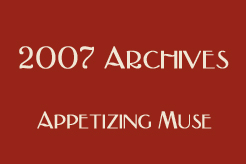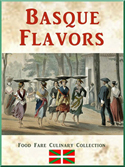Off-Path Cuisine
![]() Posted
Sat, 11/24/07
Posted
Sat, 11/24/07
Ever wonder what people eat in Afghanistan?
![]() Afghanistan Online: Afghan Cooking (with recipes)
Afghanistan Online: Afghan Cooking (with recipes)
When I wrote food articles for the web sites Savorys by Shenanchie and Food Fare, I used to try and pick off-beat cultures to research in order to come up with material. The odder the food and culture the better. This is not to say that Afghan food – or any other culture's cuisine – is odd, but anything off the beaten path is interesting to me.
Back in the day, I wrote about easily recognizable foods, such as ones found in the British Isles, America, France, Germany, Greece, Japan, Mexico and Spain. I also delved into the cultures of Australia, Canada, Madagascar, Monaco, Poland, Russia, Sweden, Switzerland, and Thailand with bits about Basque traditions and food in the medieval age.
I have to admit my favorite pieces were about the British Isles (England, Ireland, Scotland and Wales), but I also enjoyed the research and writing of the articles about Basque food and culture, and typical cuisine during the medieval period of history.
Here's part of my Basque Flavors article, which covered mealtimes:
The Basque are particular about eating with the seasons. Meals tend to have a leisurely pace and revolve around multiple courses.
Lunch and dinner typically begin with soup, which can sometimes be accompanied by platters of salad and meats. Vegetables or an omelet will follow, such as asparagus or artichokes. The main course is usually fish for those living by the coast, or lamb stew with bread to soak up the sauces. Dessert is often a simple array of cheese served with "membrillo" (quince paste) or cherry preserves. However, other sweets are typically served separate from the main meal, either an hour afterward or as a snack. The "snacks" can be a variety of treats: beignets, macaroons, meringues, or slices of Gateau Basque served with cups of foaming hot chocolate.
When a meal involves entertaining, or a Sunday lunch with family, even more food courses can be added. The meals will often begin with appetizers (such as Mushroom Pinchos or Marinated Anchovies), followed by soup, a vegetable or salad, fish, and then finally a meat course. All of the food will be accompanied by wine, which is the beverage of choice for the Basque, or cider made from a surplus of apples. Cider and apples have been a part of the Basque culture for such a long period that it is often thought they introduced the fruit and its production to Normandy, the French region famous for its cultivation of apples and cider.
After the meat, cheese, fruit or a dessert such as Crème Caramel can be eaten, followed by coffee in small cups, with brandy and liqueurs. After a short respite, deep-fried pastry fritters might be served.
Excerpt provided from Basque Flavors.
(C) 2003-2014 Shenanchie/ Food Fare.
More to come soon . . .
*POSTSCRIPT: Basque Flavors is now available as part of the Food Fare Culinary Collection.
![]() Tags: Culinary Collection;
Food Articles
Tags: Culinary Collection;
Food Articles
![]() Send
Comment >
Send
Comment >


